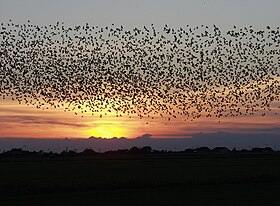| Common name
|
Binomial name
|
Population
|
Status
|
Trend
|
Notes
|
Image
|
| Turquoise-throated puffleg |
Eriocnemis godini |
1-49[1] |
CR[1] |
Unknown[1] |
Maximum estimate; may be extinct.[1] |

|
| Santa Marta sabrewing |
Campylopterus phainopeplus |
1-49[2] |
CR[2] |
 [2] [2] |
Preliminary estimate for mature individuals only.[2] |

|
| Blue-bearded helmetcrest
|
Oxypogon cyanolaemus
|
50-249[3] |
CR[3]
|
 [3] [3]
|
Estimate for mature individuals only.[3]
|

|
| Blue-throated hillstar
|
Oreotrochilus cyanolaemus
|
80-110[4] |
CR[4]
|
 [4] [4]
|
Estimate for mature individuals only. Subpopulations include 30-50 mature individuals in Cerro de Arcos and Moras, 30–40 in Guanazan and Burrourco, and <20 in Fierro Urco.[4]
|

|
| Black-breasted puffleg |
Eriocnemis nigrivestis |
100-150[5] |
EN[5] |
 [5] [5] |
Estimate is for mature individuals only.[5] |

|
| Gorgeted puffleg
|
Eriocnemis isabellae
|
250-999[6] |
CR[6]
|
 [6] [6]
|
Estimate is for mature individuals only.[6]
|
|
| Buffy helmetcrest
|
Oxypogon stuebelii
|
250-999[7] |
VU[7]
|
 [7] [7]
|
Preliminary, precautionary estimate for mature individuals only.[7]
|

|
| Dark-rumped swift |
Apus acuticauda |
250-999[8] |
VU[8] |
 [8] [8] |
Estimate for mature individuals is 250–700.[8] |
|
| Colorful puffleg |
Eriocnemis mirabilis |
250-999[9] |
EN[9] |
 [9] [9] |
Estimate for mature individuals only.[9] |
|
| Dusky starfrontlet |
Coeligena orina |
250-2,499[10] |
EN[10] |
 [10] [10] |
Estimate for mature individuals only.[10] |

|
| Sapphire-bellied hummingbird |
Chrysuronia lilliae |
285-440[11] |
EN[11] |
 [11] [11] |
Estimate is for mature individuals only.[11] |

|
| Chilean woodstar |
Eulidia yarrellii |
316[12] |
CR[12] |
 [12] [12] |
Mature individuals estimate is 210.[12] |

|
| Atiu swiftlet
|
Aerodramus sawtelli
|
340-400[13] |
VU[13]
|
 [13] [13]
|
This estimate is for mature individuals only. It comes from detailed surveys over the past three decades.[13]
|

|
| Grey-bellied comet |
Taphrolesbia griseiventris |
350-1,500[14] |
EN[14] |
 [14] [14] |
Equal to 250-999 mature individuals.[14] |
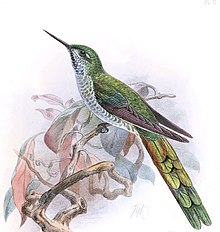
|
| Marvellous spatuletail |
Loddigesia mirabilis |
350-1,500[15] |
EN[15] |
 [15] [15] |
Equal to 250-999 mature individuals.[15] |

|
| Short-crested coquette |
Lophornis brachylophus |
350-1,500[16] |
CR[16] |
 [16] [16] |
Equal to 250-999 mature individuals.[16] |
|
| Santa marta blossomcrown |
Anthocephala floriceps |
500-2,500[17] |
VU[17] |
 [17] [17] |
Estimate is for mature individuals only.[17] |

|
| Long-tailed woodnymph
|
Thalurania watertonii
|
1,000-2,499[18] |
EN[18]
|
 [18] [18]
|
Estimate is for mature individuals only.[18]
|

|
| Tres marias hummingbird
|
Cyanthus lawrencei
|
1,000-2,499[19] |
NT[19]
|
 [19] [19]
|
Preliminary estimate for mature individuals only.[19]
|
|
| Oaxaca hummingbird |
Eupherusa cyanophrys |
1,000-2,499[20] |
EN[20] |
 [20] [20] |
Equal to 600–1,700 mature individuals.[20] |

|
| Violet-throated metaltail |
Metallura baroni |
1,000-2,499[21] |
EN[21] |
 [21] [21] |
Equates to 600–1,700 mature individuals.[21] |

|
| Tolima blossomcrown
|
Anthocephala berlepschi
|
1,000-4,500[22] |
VU[22]
|
 [22] [22]
|
Estimate is for mature individuals only.[22]
|
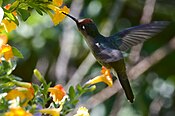
|
| Purple-backed sunbeam |
Aglaeactis aliciae |
1,500-4,000[23] |
VU[23] |
 [23] [23] |
Equal to 1,000-2,499 mature individuals.[23] |

|
| Esmeraldas woodstar |
Chaetocercus berlepschi |
1,600-3,900[24] |
VU[24] |
 [24] [24] |
Equal to 1,000-2,700 mature individuals.[24] |

|
| Glow-throated hummingbird |
Selasphorus ardens |
2,000-12,000[25] |
EN[25] |
 [25] [25] |
Estimate is for mature individuals only, calculated from supposed density and range of habitat.[25] |

|
| Juan Fernández firecrown |
Sephanoides fernandensis |
2,065-5,263[26] |
CR[26] |
 [26] [26] |
Numbers come directly from a model's calculations, therefore are specific. Equates to approximately 1,500-3,500 mature individuals.[26] |

|
| Ashy-tailed swift
|
Chaetura andrei
|
2,500-9,999[27] |
VU[27]
|
 [27] [27]
|
Preliminary estimate. This is only for mature individuals.[27]
|
|
| Seychelles swiftlet |
Aerodramus elaphrus |
2,500-3,000[28] |
VU[28] |
 [28] [28] |
Population of mature individuals estimated 1,700-2,000 (1997). Trend is suspected to be stable due to no evidence of declines/threats.[28] |

|
| Mangrove hummingbird |
Amazilia boucardi |
2,500-9,999[29] |
EN[29] |
 [29] [29] |
Equal to 1,500-7,000 mature individuals.[29] |
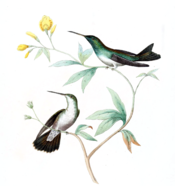
|
| Venezuelan sylph |
Aglaiocercus berlepschi |
2,500-9,999[30] |
EN[30] |
 [30] [30] |
Equal to 1,500-7,000 mature individuals.[30] |
|
| Mariana swiftlet |
Aerodramus bartschi |
2,500-9,999[31] |
EN[31] |
 [31] [31] |
This estimate comes from a previous estimation in 2015. While subpopulations on Saipan, Guam, and Aguijan are stable or increasing, a predator of the bird is being reestablished on Saipan, so a decline is expected.[31] |
|
| Hook-billed hermit
|
Glaucis dohrnii
|
2,800-24,000[32] |
VU[32]
|
 [32] [32]
|
Mature individuals estimated at 1,900-16,000. Based on habitat spread, actual population likely to be <10,000 mature individuals.[32]
|

|
| Dry-forest sabrewing
|
Campylopterus calcirupicola
|
3,600-22,000[33] |
VU[33]
|
 [33] [33]
|
Preliminary estimate. Equal to 2,400-15,000 mature individuals.[33]
|

|
| Scissor-tailed hummingbird |
Hylonympha macrocerca |
5,000-6,000[34] |
EN[34] |
 [34] [34] |
Equals to 3,000-4,000 mature individuals.[34] |

|
| Royal sunangel |
Heliangelus regalis |
5,000-12,500[35] |
NT[35] |
 [35] [35] |
Preliminary estimate. Ecuador population estimated at 2,500 individuals, Peru at 2,500-10,000 individuals. This global population is equal to 3,000-8,999 mature individuals.[35] |

|
| Little woodstar |
Chaetocercus bombus |
5,000-19,999[36] |
NT[36] |
 [36] [36] |
Preliminary estimate for mature individuals only.[36] |

|
| Mexican sheartail |
Doricha eliza |
8,500-12,500[37] |
NT[37] |
 [37] [37] |
Equal to 2,500-9,999 mature individuals. Subpopulations include <2,500 in Veracruz and 6,000-10,000 in Yucatán.[37] |

|
| Neblina metaltail |
Metallura odomae |
<10,000[38] |
LC[38] |
 [38] [38] |
Equal to <6,700 mature individuals.[38] |
|
| Honduran emerald |
Amazilia luciae |
10,000-19,999[39] |
VU[39] |
 [39] [39] |
Estimate is for mature individuals only. Equal to 5,000-10,000 breeding pairs.[39] |

|
| Chestnut-bellied hummingbird
|
Saucerottia castaneiventris
|
10,000-19,999[40] |
NT[40]
|
 [40] [40]
|
Estimate is for mature individuals only. There are multiple studies with varying estimates, so global population size may be changed.[40]
|

|
| Koepcke's hermit |
Phaethornis koepckeae |
10,000-19,999[41] |
NT[41] |
 [41] [41] |
Preliminary estimate. Equal to 6,000-15,000 mature individuals.[41] |

|
| Mascarene swiftlet |
Aerodramus francicus |
10,000-19,999[42] |
NT[42] |
 [42] [42] |
Estimate is for mature individuals. This comes from a count in 2000 of 2,244-2,610 individuals on Mauritius, with population on Reunion thought to be larger. Difficult to quantify population trend, as some populations have increased and others have decreased. An overall decrease due to habitat loss is assumed.[42] |

|
| Mexican woodnymph |
Eupherusa ridgwayi |
10,000-19,999[43] |
VU[43] |
 [43] [43] |
Equal to 6,000-15,000 mature individuals.[43] |

|
| Rothschild's swift |
Cypseloides rothschildi |
10,000-19,999[44] |
NT[44] |
 [44] [44] |
These are preliminary estimates. Mature individuals estimated to be equate to 6,000-15,000 approximately. Trend is assumed due to no evidence of declines/threats.[44] |

|
| White-tailed hummingbird |
Eupherusa poliocerca |
10,000-19,999[45] |
NT[45] |
 [45] [45] |
Equal to 6,000-15,000 mature individuals.[45] |
|
| Black inca |
Coeligena prunellei |
11,250[46] |
VU[46] |
 [46] [46] |
Equal to 7,500 mature individuals.[46] |

|
| Wedge-tailed hillstar |
Oreotrochilus adela |
<15,200[47] |
LC[47] |
 [47] [47] |
Preliminary estimate. Equal to 2,500-9,999 mature individuals.[47] |

|
| Humboldt's hummingbird
|
Chrysuronia humboldtii
|
20,000-49,999[48] |
LC[48]
|
 [48] [48]
|
Estimate is for mature individuals only.[48]
|

|
| White-tailed emerald
|
Microchera chionura
|
20,000-49,999[49] |
LC[49]
|
 [49] [49]
|
Estimate is for mature individuals only.[49]
|

|
| Coppery-headed emerald
|
Microchera cupreiceps
|
20,000-49,999[50] |
LC[50]
|
 [50] [50]
|
Estimate is for mature individuals only.[50]
|

|
| Scintillant hummingbird
|
Selasphorus scintilla
|
20,000-49,999[51] |
LC[51]
|
 [51] [51]
|
Estimate is for mature individuals only.[51]
|

|
| Volcano hummingbird
|
Selasphorus flammula
|
20,000-49,999[52] |
LC[52]
|
 [52] [52]
|
Estimate is for mature individuals only.[52]
|
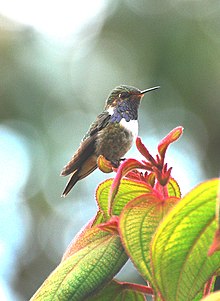
|
| Purple-throated woodstar
|
Philodice mitchellii
|
20,000-49,999[53] |
LC[53]
|
 [53] [53]
|
Estimate is for mature individuals only.[53]
|

|
| Magenta-throated woodstar
|
Philodice bryantae
|
20,000-49,999[54] |
LC[54]
|
 [54] [54]
|
Estimate is for mature individuals only.[54]
|

|
| White-bellied mountain-gem
|
Lampornis hemileucus
|
20,000-49,999[55] |
LC[55]
|
 [55] [55]
|
Estimate is for mature individuals only.[55]
|

|
| Perija metaltail
|
Metallura iracunda
|
20,000-49,999[56] |
EN[56]
|
 [56] [56]
|
No mature individual estimate available.[56]
|

|
| White-crested coquette
|
Lophornis adorabilis
|
20,000-49,999[57] |
LC[57]
|
 [57] [57]
|
Estimate is for mature individuals only.[57]
|

|
| Veraguas mango
|
Anthracothorax veraguensis
|
20,000-49,999[58] |
LC[58]
|
 [58] [58]
|
Estimate is for mature individuals only.[58]
|

|
| Mexican hermit
|
Phaethornis mexicanus
|
20,000-49,999[59] |
LC[59]
|
 [59] [59]
|
Estimate is for mature individuals only.[59]
|

|
| Costa Rican swift
|
Chaetura fumosa
|
20,000-49,999[60] |
LC[60]
|
 [60] [60]
|
Estimate is for mature individuals only. Population assumed stable due to absence of declines/threats.[60]
|
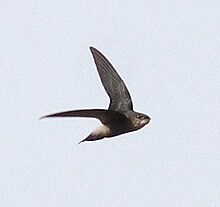
|
| White-chinned swift
|
Cypseloides cryptus
|
20,000-49,999[61] |
LC[61]
|
 [61] [61]
|
Estimate is for mature individuals only. Downward trend is due to habitat loss.[61]
|
|
| Beautiful sheartail |
Calothorax pulcher |
20,000-49,999[62] |
LC[62] |
 [62] [62] |
Estimate is for mature individuals only.[62] |

|
| Black-crested coquette |
Lophornis helenae |
20,000-49,999[63] |
LC[63] |
 [63] [63] |
Estimate is for mature individuals only.[63] |

|
| Cozumel emerald |
Cynanthus forficatus |
20,000-49,999[64] |
LC[64] |
 [64] [64] |
Estimate is for mature individuals only.[64] |
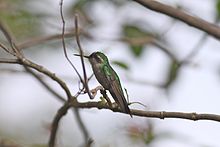
|
| Emerald-chinned hummingbird |
Abeillia abeillei |
20,000-49,999[65] |
LC[65] |
 [65] [65] |
This estimate is for mature individuals only. Trend has not been investigated, but it is suspected to be in a decline due to habitat loss.[65] |

|
| Garnet-throated hummingbird |
Lamprolaima rhami |
20,000-49,999[66] |
LC[66] |
 [66] [66] |
Estimate is for mature individuals only.[66] |

|
| Great swallow-tailed swift |
Panyptila sanctihieronymi |
20,000-49,999[67] |
LC[67] |
 [67] [67] |
Estimate is for mature individuals only.[67] |
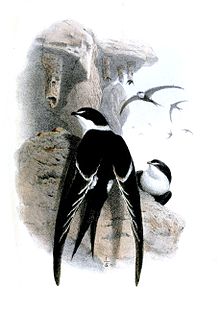
|
| Rufous sabrewing |
Pampa rufus |
20,000-49,999[68] |
LC[68] |
 [68] [68] |
Estimate is for mature individuals only.[68] |
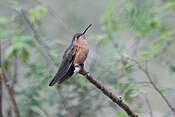
|
| Slender sheartail |
Doricha enicura |
20,000-49,999[69] |
LC[69] |
 [69] [69] |
Estimate is for mature individuals.[69] |

|
| Sparkling-tailed woodstar |
Tilmatura dupontii |
20,000-49,999[70] |
LC[70] |
 [70] [70] |
Estimate is for mature individuals only.[70] |

|
| White-fronted swift |
Cypseloides storeri |
20,000-49,999[71] |
DD[71] |
Unknown[71] |
This estimate was made in 2019. Trend is unknown due to uncertainties regarding the species habitat requirements.[71] |
|
| Wine-throated hummingbird |
Selasphorus ellioti |
20,000-49,999[72] |
LC[72] |
 [72] [72] |
Estimate is for mature individuals only.[72] |

|
| Xantus's hummingbird |
Basilinna xantusii |
20,000-49,999[73] |
LC[73] |
 [73] [73] |
Estimate is for mature individuals only.[73] |
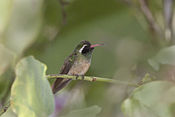
|
| Bee hummingbird
|
Mellisuga helenae
|
22,000-66,000[74] |
NT[74]
|
 [74] [74]
|
Estimate for mature individuals only.[74]
|

|
| Plain swift |
Apus unicolor |
22,500-60,000[75] |
LC[75] |
Unknown[75] |
Breeding population is confined to Europe, estimated to be 15,000-40,000 mature individuals.[75] |

|
| Hooded visorbearer
|
Augastes lumachella
|
35,000-100,000[76] |
NT[76]
|
 [76] [76]
|
Estimate is for mature individuals only, and is calculated from mapped range and percent of range occupied.[76]
|

|
| Dot-eared coquette
|
Lophornis gouldii
|
43,000-563,000[77] |
NT[77]
|
 [77] [77]
|
Tentative estimate. Equal to 28,000-376,000 mature individuals.[77]
|

|
| White-tailed sabrewing
|
Campylopterus ensipennis
|
50,000-99,999[78] |
NT[78]
|
 [78] [78]
|
Estimate is for mature individuals only.[78]
|
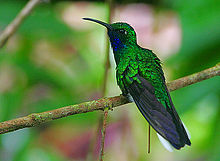
|
| Charming hummingbird
|
Polyerata decora
|
50,000-499,999[79] |
LC[79]
|
 [79] [79]
|
Estimate is for mature individuals only.[79]
|

|
| Sapphire-throated hummingbird
|
Chrysuronia coeruleogularis
|
50,000-499,999[80] |
LC[80]
|
 [80] [80]
|
Estimate is for mature individuals only.[80]
|

|
| Snowy-bellied hummingbird
|
Saucerottia edward
|
50,000-499,999[81] |
LC[81]
|
 [81] [81]
|
Estimate is for mature individuals only.[81]
|

|
| Blue-tailed hummingbird |
Saucerottia cyanura |
50,000-499,999[82] |
LC[82] |
 [82] [82] |
Estimate is for mature individuals only.[82] |
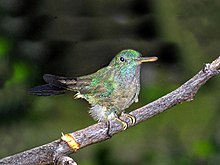
|
| Scaly-breasted hummingbird |
Phaeochroa cuvierii |
50,000-499,999[83] |
LC[83] |
 [83] [83] |
Estimate is for mature individuals only.[83] |
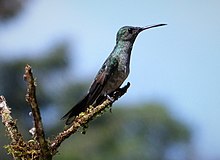
|
| Black-bellied hummingbird
|
Eupherusa nigriventris
|
50,000-499,999[84] |
LC[84]
|
 [84] [84]
|
Estimate is for mature individuals only.[84]
|

|
| Snowcap
|
Microchera albocoronata
|
50,000-499,999[85] |
LC[85]
|
 [85] [85]
|
Estimate is for mature individuals only.[85]
|

|
| Blue-throated goldentail
|
Cholrestes eliciae
|
50,000-499,999[86] |
LC[86]
|
 [86] [86]
|
Estimate is for mature individuals only.[86]
|

|
| Garden emerald
|
Chlorostilbon assimilis
|
50,000-499,999[87] |
LC[87]
|
 [87] [87]
|
Estimate is for mature individuals only.[87]
|

|
| Bumblebee hummingbird
|
Selasphorus heloisa
|
50,000-499,999[88] |
LC[88]
|
 [88] [88]
|
Estimate for mature individuals only.[88]
|

|
| Violet-bellied hummingbird
|
Chlorestes julie
|
50,000-499,999[89] |
LC[89]
|
 [89] [89]
|
Estimate is for mature individuals only.[89]
|

|
| Amethyst-throated mountaingem |
Lampornis amethystinus |
50,000-499,999[90] |
LC[90] |
 [90] [90] |
Estimate is for mature individuals only.[90] |

|
| Purple-throated mountain-gem
|
Lampornis calolaemus
|
50,000-499,999[91] |
LC[91]
|
 [91] [91]
|
Estimate is for mature individuals only.[91]
|

|
| Fiery-throated hummingbird
|
Panterpe insignis
|
50,000-499,999[92] |
LC[92]
|
 [92] [92]
|
Estimate is for mature individuals only.[92]
|

|
| Rufous-crested coquette
|
Lophornis delattrei
|
50,000-499,999[93] |
LC[93]
|
 [93] [93]
|
Estimate is for mature individuals only.[93]
|

|
| White-whiskered hermit
|
Phaethornis yaruqui
|
50,000-499,999[94] |
LC[94]
|
 [94] [94]
|
Estimate is for mature individuals only.[94]
|

|
| Chapman's swift
|
Chaetura chapmani
|
50,000-499,999[95] |
LC[95]
|
 [95] [95]
|
Estimate is for mature individuals only.[95]
|

|
| White-tipped sicklebill
|
Eutoxeres aquila
|
50,000-499,999[96] |
LC[96]
|
 [96] [96]
|
Estimate is for mature individuals only.[96]
|

|
| Dusky hummingbird |
Phaeoptila sordidus |
50,000-499,999[97] |
LC[97] |
 [97] [97] |
Estimate is for mature individuals only.[97] |

|
| Golden-crowned emerald |
Cyanthus auriceps |
50,000-499,999[98] |
LC[98] |
 [98] [98] |
Estimate is for mature individuals only.[98] |

|
| Green-throated mountaingem |
Lampornis viridipallens |
50,000-499,999[99] |
LC[99] |
 [99] [99] |
Estimate is for mature individuals only.[99] |
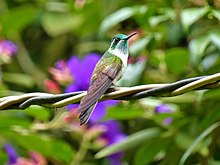
|
| Plain-capped starthroat |
Heliomaster constantii |
50,000-499,999[100] |
LC[100] |
 [100] [100] |
Estimate is for mature individuals only.[100] |
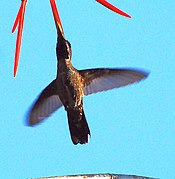
|
| Purple-crowned fairy |
Heliothryx barroti |
50,000-499,999[101] |
LC[101] |
 [101] [101] |
No mature individuals estimate is given.[101] |

|
| Stripe-tailed hummingbird |
Eupherusa eximia |
50,000-499,999[102] |
LC[102] |
 [102] [102] |
Estimate is for mature individuals only.[102] |
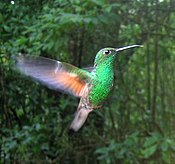
|
| Stripe-throated hermit |
Phaethornis striigularis |
50,000-499,999[103] |
LC[103] |
 [103] [103] |
Estimate is for mature individuals only.[103] |

|
| Violet sabrewing |
Campylopterus hemileucurus |
50,000-499,999[104] |
LC[104] |
 [104] [104] |
Estimate is for mature individuals only.[104] |

|
| White-naped swift |
Streptoprocne semicollaris |
50,000-499,999[105] |
LC[105] |
 [105] [105] |
Estimate is for mature individuals only (2019).[105] |

|
| Tooth-billed hummingbird
|
Androdon aequatorialis
|
78,000-130,000[106] |
LC[106]
|
 [106] [106]
|
Estimate is calculated from density and habitat range. Equates 52,000-87,000 mature individuals.[106]
|

|
| Black swift
|
Cypseloides niger
|
170,000[107] |
VU[107]
|
 [107] [107]
|
This estimate is for mature individuals only, and was made in 2019.[107]
|
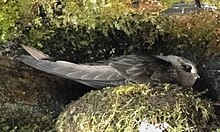
|
| Lucifer hummingbird
|
Calothorax lucifer
|
200,000[108] |
LC[108]
|
 [108] [108]
|
Estimate is for mature individuals only.[108]
|

|
| Saw-billed hermit
|
Ramphodon naevius
|
262,000-2,560,000[109] |
LC[109]
|
 [109] [109]
|
Tentative estimate based on habitat size. Mature individuals estimated at 175,000-1,710,000.[109]
|

|
| Greenish puffleg
|
Haplophaedia aureliae
|
336,000-570,000[110] |
LC[110]
|
 [110] [110]
|
Estimate is for mature individuals only. Equal to 168,000-285,000 pairs.[110]
|
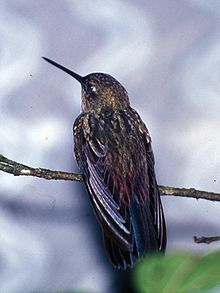
|
| Blue-chested hummingbird
|
Polyerata amabilis
|
500,000-4,999,999[111] |
LC[111]
|
 [111] [111]
|
Estimate is for mature individuals only.[111]
|

|
| Steely-vented hummingbird
|
Saucerottia saucerottei
|
500,000-4,999,999[112] |
LC[112]
|
 [112] [112]
|
Estimate is for mature individuals only.[112]
|

|
| Azure-crowned hummingbird |
Saucerottia cyanocephala |
500,000-4,999,999[113] |
LC[113] |
 [113] [113] |
Estimate is for mature individuals only.[113] |
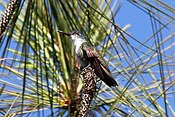
|
| Bronze-tailed plumeleteer
|
Chalybura urochrysia
|
500,000-4,999,999[114] |
LC[114]
|
 [114] [114]
|
Estimate is for mature individuals only.[114]
|

|
| Violet-headed hummingbird
|
Klais guimeti
|
500,000-4,999,999[115] |
LC[115]
|
 [115] [115]
|
Estimate is for mature individuals only.[115]
|
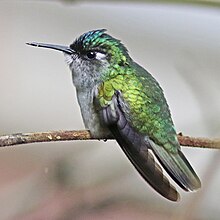
|
| Canivet's emerald
|
Cynanthus canivetii
|
500,000-4,999,999[116] |
LC[116]
|
 [116] [116]
|
Estimate is for mature individuals only.[116]
|

|
| Green-crowned brilliant
|
Heliodoxa jacula
|
500,000-4,999,999[117] |
LC[117]
|
 [117] [117]
|
Estimate is for mature individuals only.[117]
|

|
| Green-breasted mango
|
Anthracothorax prevostii
|
500,000-4,999,999[118] |
LC[118]
|
[118]
|
Estimate is for mature individuals only.[118]
|

|
| Brown violet-ear
|
Colibri delphinae
|
500,000-4,999,999[119] |
LC[119]
|
 [119] [119]
|
Estimate is for mature individuals only.[119]
|
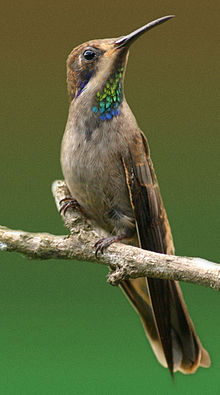
|
| Green-fronted lancebill
|
Doryfera ludovicae
|
500,000-4,999,999[120] |
LC[120]
|
 [120] [120]
|
Estimate is for mature individuals only.[120]
|

|
| Green hermit
|
Phaethornis guy
|
500,000-4,999,999[121] |
LC[121]
|
 [121] [121]
|
Estimate is for mature individuals only.[121]
|

|
| Pale-bellied hermit
|
Phaethornis anthophilus
|
500,000-4,999,999[122] |
LC[122]
|
 [122] [122]
|
Estimate is for mature individuals only.[122]
|
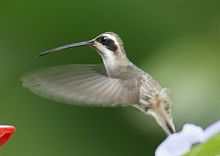
|
| Band-tailed barbthroat
|
Threnetes ruckeri
|
500,000-4,999,999[123] |
LC[123]
|
 [123] [123]
|
Estimate is for mature individuals only.[123]
|

|
| Chestnut-collared swift |
Streptoprocne rutila |
500,000-4,999,999[124] |
LC[124] |
 [124] [124] |
This estimate is for mature individuals only.[124] |
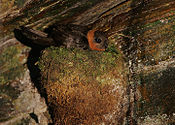
|
| Bronzy hermit
|
Glaucis aeneus
|
500,000-4,999,999[125] |
LC[125]
|
 [125] [125]
|
Estimate is for mature individuals only.[125]
|

|
| Cinnamon hummingbird |
Amazilia rutila |
500,000-4,999,999[126] |
LC[126] |
 [126] [126] |
Estimate is for mature individuals only.[126] |

|
| Green violetear |
Colibri thalassinus |
500 000 – 4 999 999[127] |
LC[127] |
Unknown[127] |
|

|
| Lesser swallow-tailed swift |
Panyptila cayennensis |
500,000-4,999,999[128] |
LC[128] |
 [128] [128] |
Estimate is for mature individuals only.[128] |
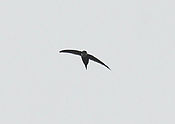
|
| Long-billed starthroat |
Heliomaster longirostris |
500,000-4,999,999[129] |
LC[129] |
 [129] [129] |
Estimate is for mature individuals only.[129] |

|
| White-bellied emerald |
Amazilia candida |
500,000-4,999,999[130] |
LC[130] |
 [130] [130] |
Estimate is for mature individuals only.[130] |

|
| Buff-bellied hummingbird
|
Amazilia yucatanensis
|
610,000[131] |
LC[131]
|
Unknown[131]
|
Estimate is for mature individuals only.[131]
|
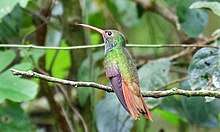
|
| Pallid swift |
Apus pallidus |
800,000-1,499,999[132] |
LC[132] |
 [132] [132] |
Preliminary estimate extrapolated from European data, which is home to 126,000-213,000 mature individuals.[132] |

|
| Vaux's swift
|
Chaetura vauxi
|
860,000[133] |
LC[133]
|
 [133] [133]
|
Estimate is for mature individuals only.[133]
|
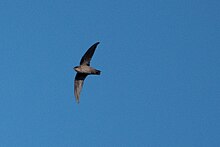
|
| Alpine swift |
Tachymarptis melba |
1,000,000-2,499,999[134] |
LC[134] |
 [134] [134] |
Estimate for mature individuals only. Preliminary estimate. European population estimated at 302,000-653,000 mature individuals.[134] |
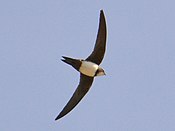
|
| Allen's hummingbird
|
Selasphorus sasin
|
1,500,000[135] |
LC[135]
|
 [135] [135]
|
Estimate is for mature individuals only.[135]
|

|
| Berylline hummingbird
|
Saucerottia beryllina
|
2,000,000[136] |
LC[136]
|
 [136] [136]
|
Estimate is for mature individuals only.[136]
|
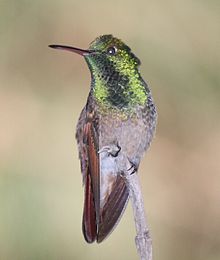
|
| White-eared hummingbird
|
Basilinna leucotis
|
2,000,000[137] |
LC[137]
|
 [137] [137]
|
Estimate is for mature individuals only.[137]
|

|
| Blue-throated hummingbird
|
Lampornis clemenciae
|
2,000,000[138] |
LC[138]
|
 [138] [138]
|
Estimate is for mature individuals only.[138]
|

|
| Magnificent hummingbird
|
Eugenes fulgens
|
2,000,000[139] |
LC[139]
|
 [139] [139]
|
Estimate is for mature individuals only.[139]
|

|
| White-throated swift
|
Aeronautes saxatalis
|
3,200,000[140] |
LC[140]
|
 [140] [140]
|
Estimate is for mature individuals only.[140]
|
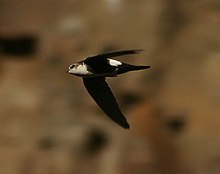
|
| Costa's hummingbird
|
Calypte costae
|
3,400,000[141] |
LC[141]
|
 [141] [141]
|
Estimate is for mature individuals only.[141]
|

|
| Grey-breasted sabrewing
|
Campylopterus largipennis
|
4,000,000-20,000,000[142] |
LC[142]
|
 [142] [142]
|
Tentative estimate from density and range, equal to 3,000,000-13,000,000 mature individuals.[142]
|

|
| Calliope hummingbird
|
Selasphorus calliope
|
4,500,000[143] |
LC[143]
|
 [143] [143]
|
Estimate is for mature individuals only.[143]
|

|
| Rufous-tailed hummingbird |
Amazilia tzacatl |
5,000,000-50,000,000[144] |
LC[144] |
 [144] [144] |
Estimate is for mature individuals only.[144] |
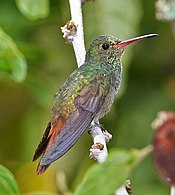
|
| Black-throated mango
|
Anthracothorax nigricollis
|
5,000,000-50,000,000[145] |
LC[145]
|
 [145] [145]
|
Estimate is for mature individuals only.[145]
|
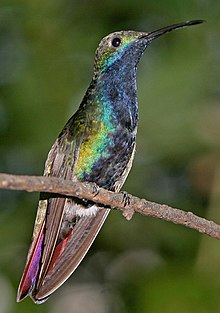
|
| Rufous-breasted hermit
|
Glaucis hirsutus
|
5,000,000-50,000,000[146] |
LC[146]
|
 [146] [146]
|
Estimate is for mature individuals only.[146]
|

|
| White-collared swift |
Streptoprocne zonaris |
5,000,000-50,000,000[147] |
LC[147] |
 [147] [147] |
This estimate is for mature individuals only (made in 2019). Decline due to habitat loss.[147] |

|
| White-necked jacobin |
Florisuga mellivora |
5,000,000-50,000,000[148] |
LC[148] |
 [148] [148] |
Estimate is for mature individuals only.[148] |

|
| Short-tailed swift
|
Chaetura brachyura
|
5,000,000-50,000,000[149] |
LC[149]
|
 [149] [149]
|
Estimate is for mature individuals only.[149]
|
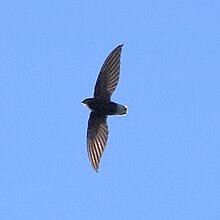
|
| Black-chinned hummingbird
|
Archilochus alexandri
|
8,800,000[150] |
LC[150]
|
 [150] [150]
|
Estimate is for mature individuals only.[150]
|
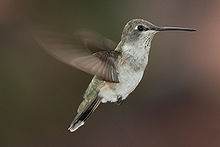
|
| Anna's hummingbird
|
Calypte anna
|
9,600,000[151] |
LC[151]
|
 [151] [151]
|
Estimate is for mature individuals only.[151]
|
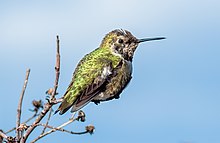
|
| Broad-tailed hummingbird
|
Selasphorus platycercus
|
9,800,000[88] |
LC[88]
|
 [88] [88]
|
Estimate is for mature individuals only.[88]
|

|
| Chimney swift |
Chaetura pelagica |
15,000,000[152] |
VU[152] |
 [152] [152] |
Estimate for mature individuals is 7,700,000 (2016 survey).[152] |

|
| Rufous hummingbird
|
Selasphorus rufus
|
22,000,000[153] |
NT[153]
|
 [153] [153]
|
Estimate is for mature individuals only.[153]
|
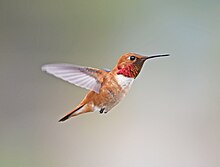
|
| Ruby-throated hummingbird
|
Archilochus colubris
|
36,000,000[154] |
LC[154]
|
 [154] [154]
|
Estimate is for mature individuals only.[154]
|

|
| Grey-rumped swift
|
Chaetura cinereiventris
|
50,000,000[155] |
LC[155]
|
 [155] [155]
|
This estimate is for mature individuals only.[155]
|
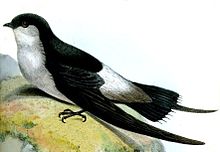
|
| Common swift |
Apus apus |
95,000,000-164,999,999[156] |
LC[156] |
 [156] [156] |
Preliminary estimate is for mature individuals. European population estimated at 38,200,000-65,000,000 mature individuals.[156] |

|
